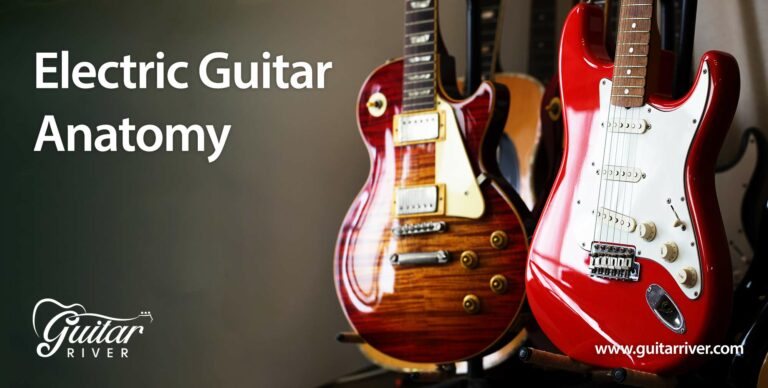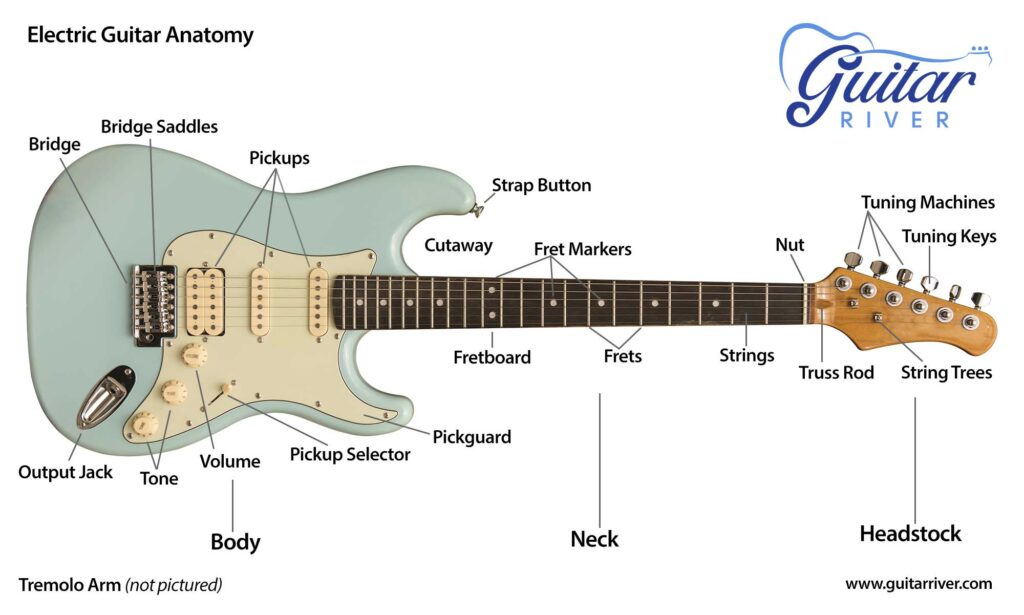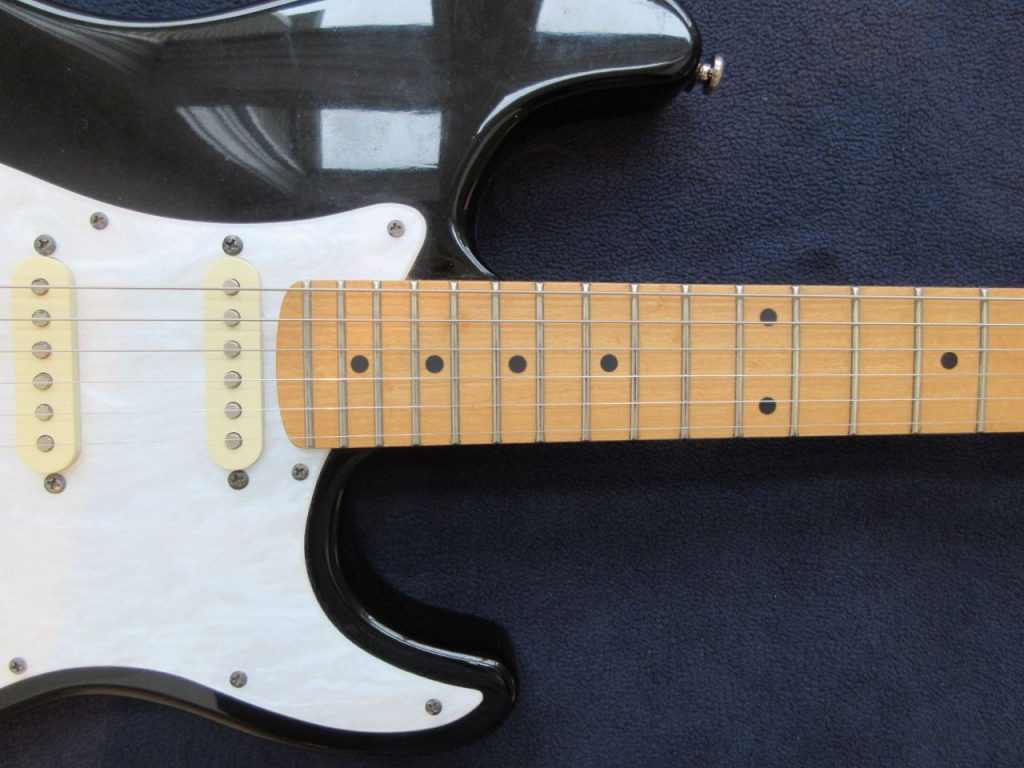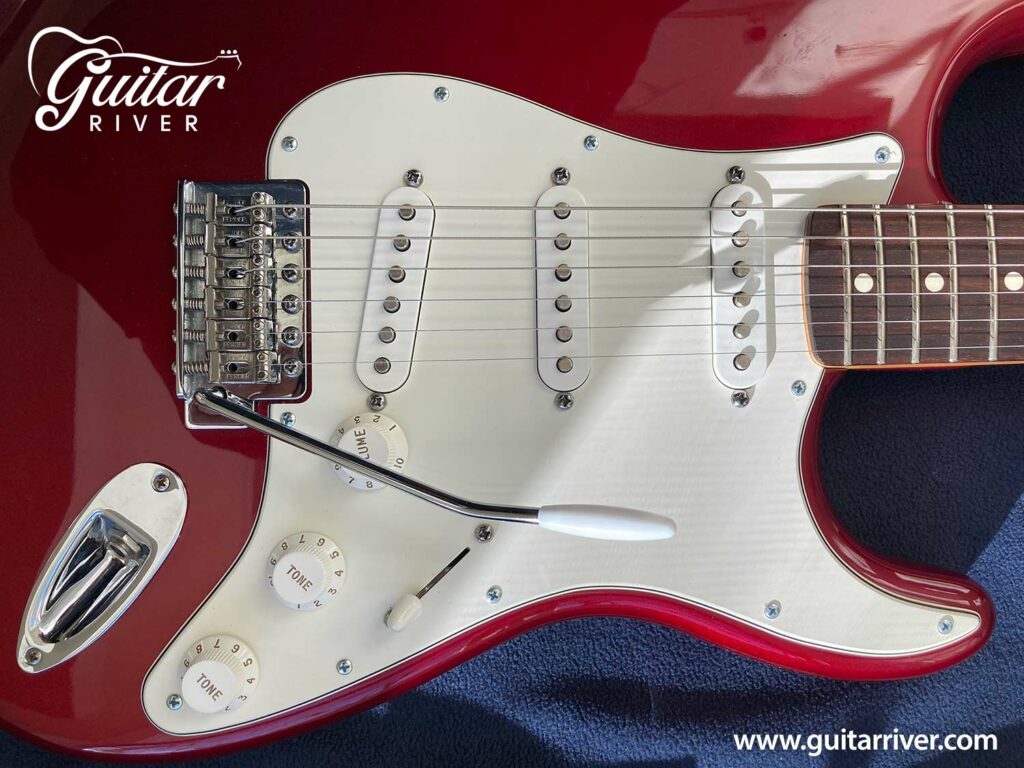Guitar River is reader-supported. We may earn a commission when you make a purchase using the links on our site.
Learn more.
Electric Guitar Anatomy: The Parts Of The Electric Guitar

If you are new to the electric guitar, you might be wondering about all the various parts of your guitar. What are they called, and what do they do? Knowing the different parts of an electric guitar will help you when you are shopping for a new guitar, and when you talk with other guitar players.
The anatomy of an electric guitar consists of the body, neck, headstock, fretboard, frets, nut, tuning machines, strings, pickups, volume and tone controls, bridge, saddles, output jack, and other parts. You’ll see all the various parts of the electric guitar in the following illustration.

It’s helpful to know the parts of an electric guitar, and how to use them. We are going to take a look at each part of the guitar, and briefly explain what it does. We will try to demystify the anatomy of the electric guitar in this post.
Body
The body of the electric guitar is wood, and comes in a few primary shapes and styles. The main body shapes are variations of double-cut and single-cut body types.
The cutaway refers to the curvy, scooped-out area near the neck of the guitar. The main purpose of the cutaway is so that your hand can access the upper frets on a guitar.
The body shape will vary depending on the style of guitar and the manufacturer. As you get more familiar with the instrument, you will learn to easily spot the different types of electric guitar bodies.
Outside of the main body shapes, there are a variety of unique and adventurous guitar styles. Check out our post about electric guitar shapes for a rundown on why electric guitars are shaped the way they are.
The body of the electric guitar is where the electronics of your instrument live. As it rests against your body when you are playing, some electric guitars have ergonomic curves that make playing more comfortable.
The wood used for the guitar body will also vary between guitars. There is a long-standing debate as to whether the different types of wood affect the tonal properties of an electric guitar.
Just know for now, this is the main part of your instrument. You can read more about what electric guitars are made of if you want to go further.
Neck
The guitar neck is the long piece of wood extending out from the top of the body. The guitar strings stretch from the bridge up to the headstock at the end of the neck.
The neck is where you place your fretting hand. This would be your left hand if you are a right-handed guitar player.
The neck profile varies depending on the guitar model, and is described by its shape, such as a modern C shape. This is just a reference to the curvature of the guitar neck.
Electric guitar necks are either attached to the body with screws (a bolt-on neck), or glued to the body (a set neck). Some guitars use neck-through construction, which means the neck extends through the body.
Headstock
The headstock is the piece of wood at the top of the neck where the tuning machines are located. This is often just the same piece of wood as the neck, but it can be a separate piece of wood attached to the neck with a scarf joint.
This is where your strings are attached and where you tune the strings. In the case of a headless guitar, your strings are adjusted at the bridge.
The style of guitar determines the headstock shape. You will see six inline tuning machines on one side of the headstock on S-style guitars. Sometimes the tuning machines are on the underside of the headstock, and this is called a reverse headstock.

On LP-style guitars, the tuning machines are mounted three on each side of the headstock. The shape of the headstock will be unique to the manufacturer, and is even trademarked.
You might notice a small piece of metal or plastic on the headstock that guides the top B and E strings. This is called the string tree, and is there to keep a consistent angle on the strings from the nut to the tuning machines.
Tuning Machines
The tuning machines are the metal mechanisms on the headstock where you attach the guitar strings, and what you use to tune the strings to pitch. These are also called machine heads, tuning keys, tuners, and other various names.
The guitar string is fed through the tuning post, and wraps around the cylinder. By turning the tuning key, you increase or decrease the tension on the guitar string, which raises or lowers the pitch.
Tuning machines can be standard or locking tuning machines. The locking tuners just help you change the string faster and provide a little more stability.
Staggered tuning machines vary in height in order to keep the angle consistent from the low E to the high E strings with six inline tuners. With this approach, the tuning machines are shorter at the top of the headstock since there is more distance between the tuner and the nut. The shorter post increases the angle of the string.
Truss Rod & Cover
You may see an opening or a small plastic cover at the headstock. This is for the truss rod. The truss rod is a metal bar that extends through the neck. You tighten or loosen the truss rod in order to adjust the bend in the neck. Guitars either have a flat neck or a slight amount of bend, called relief. This allows enough room for the string to vibrate and not hit the frets.
The truss rod can also be located at the bottom of the neck with a spoke-nut truss rod. On older, vintage guitars, you may have to remove the neck to adjust the truss rod as the access point will be hidden by the guitar body.
Nut
The small, notched strip of material at the top of the neck where the strings are resting is called the nut. The nut provides a guide for the guitar strings, and keeps them in place. Without the nut, the strings would be moving around on your fretboard as you play.
Nuts can be made of plastic, bone, or a composite material. Nuts can also be metal as in the Floyd Rose locking tremolo system. Although less common, there are roller nuts which can reduce the string friction.
A guitar nut is also someone who is obsessed with guitars. If you feel like you might be a guitar nut, it’s okay, this is a safe space!
Fretboard
The fretboard is the thin piece of wood on top of the neck. This is usually a separate piece of wood, often maple or rosewood. A maple fretboard is a light blond color, while the rosewood fretboard is a dark brown color. The fretboard is also called the fingerboard. The two terms are interchangeable.

Strings
The strings of the guitar are metal, and extend from the bridge to the headstock. You pluck or pick the strings to make a sound. The vibration of the strings is translated to an electrical signal via the pickups, and creates the electric guitar sound.
Electric guitar strings are commonly made of nickel-plated steel. The first three strings are unwound, and the last three are wound. You can see this if you look at the strings closely. The last three strings (E, A, and D) are thicker than the first three (G, B, and E).
Strings are either roundwound, or flatwound. Without going too deep here, the flatwound strings reduce the wear on your frets and offer a mellower tone. Roundwound strings are brighter and more commonly used, but do wear the frets faster.
Frets
Unlike a violin, cello, or other classical stringed instrument, a guitar has metal fret wire at specific intervals along the fretboard. This is where you place your finger in order to play a different note.
You press with your finger just behind the fret to change the note being played. By pressing the string down at a fret, it effectively changes the length of the string and raises or lowers the pitch. The higher up the fretboard you go towards the guitar body, the higher the pitch of the note.
Most electric guitars have 22 frets, while others have a full two octaves, or 24 frets. The notes at the 12th fret are a repeat of the open string notes, but one octave higher.
Electric guitars can have different types of fret wire installed. You’ll find the terms jumbo, medium jumbo, narrow tall, and others used to describe the frets. This just refers to the size of the fret wire.
Most fret wire is a nickel silver alloy, though some guitars come equipped with stainless steel frets. The stainless steel will last longer as it is a harder metal.
Fret Markers
The dots or markers that you see at regular intervals on the fretboard are called fret markers or inlays. Depending on your guitar, these are small dots, rectangles, triangles, or another shape.
Fret markers are along the side of the neck as well. The markers provide a navigational cue, and help you find the right notes when playing.
Usually a plastic material, these can be made out of abalone, or other materials too. The fret markers on the side of the neck are sometimes made of a luminous material that you can see on a dark stage. Check out the Luminlay site for more information.
Strap Buttons
The strap buttons are attachments on the body of the guitar where you connect your guitar strap. Guitars have two of these, one at the bottom of the body, and one of the top near the neck.
Pickguard
The pickguard is the flat, plastic piece under the strings. This protects the body of the guitar from scratches that can occur with your guitar pick. However, not all guitars have pickguards. Pickguards come in different shapes and patterns. It’s common to see a plain, solid color, as well as tortoise shell type patterns.
Pickups
The electric guitar pickups transform the sound and vibration of the strings to an electrical signal. They are made up of magnetized metal pole pieces, wrapped with copper wire. The magnets can be different types such as alnico or ceramic. Check out our article about the difference between alnico and ceramic pickups.
Guitar pickups are classified as either single-coil or humbucker. The single-coils are narrow pickups like you see on the Strat, and the humbuckers are wider, like two single-coils stuck together. Humbucker pickups are designed to be noise canceling and typically have a bigger sound than single coil pickups.

Electric guitars can have anywhere from one to three pickups. The pickup closest to the neck is called the neck pickup or rhythm pickup. The pickup closest to the bridge is the bridge or lead pickup. And the one in the middle is the middle pickup.
Pickup Selector
Electric guitars have a pickup selector switch that allows you to switch between the different pickups. Usually, this is a three or five-way switch.
With a three-way switch, you have the option of using the neck, middle, or bridge pickups on their own. If there is no middle pickup, the middle position is the neck and the bridge combined.
A five-way selector switch has two additional options that combine the neck and the middle pickups or the bridge and the middle pickups using switch positions two and four.
Switches
Other electric guitars such as the Fender Jazzmaster and the Fender Jaguar have additional switches that toggle between rhythm and lead circuits. This gives you additional tonal possibilities with your electric guitar. Check out our article on electric guitar controls for more details.
Bridge
The bridge is where the strings connect to the guitar body. The bridge can either be a fixed bridge, or a tremolo bridge. A fixed bridge doesn’t move, while a tremolo allows you to change the pitch up or down.
S-style or Strat guitars traditionally have a tremolo, while LP-style guitars have a fixed or stop-tail bridge. Some tremolo bridges are locking such as the Floyd Rose bridge.
The strings can either go through the guitar body such as on a Tele, through the tremolo block such as on a Strat, or through a stopbar tailpiece on LP-style guitars.
Bridge Saddles
The bridge saddles are individual metal pieces in the bridge where the string rests. The saddles are used to adjust the action and the intonation of the guitar. The saddles can be moved up and down to set the action, and forward and back to adjust the intonation.
Tremolo
The tremolo is used to change the pitch of the strings while playing. This can be a wavering, subtle effect, or a dramatic dive bomb. Tremolos come in different types. The Strat has a straightforward tremolo with either a six-screw or a two-point attachment. Some other tremolo systems include the Bigsby and the Floyd Rose locking tremolo. You might hear a tremolo called a whammy bar on occasion.
Volume Knob
The volume knob on an electric guitar does just what you would expect. It increases or decreases the output volume of the guitar. You might also hear people talk about pots or potentiometers. This is just the technical term for the volume and tone controls.
Tone Knob
The tone controls on an electric guitar are used to brighten or darken the sound of a pickup. Sometimes a guitar will have just one tone control, or there may be multiple tone controls for the different pickups. Increasing the tone makes the pickup sound brighter, and decreasing it makes it sound darker. Generally speaking, when you decrease the tone, you reduce the high-end frequencies, creating a mellower sound.
Output Jack
The output jack is where your guitar cable connects to the electric guitar. The cable carries the signal to your amp or audio interface. You can also plug a wireless transmitter into your output jack to go wireless with your electric guitar. The jack is either on the front or side of the guitar body, depending on the type of guitar.
Wrapping Up
Now you have a better understanding of the anatomy of the electric guitar. You don’t have to know everything about the guitar in order to play it, but it helps to have some knowledge of the different parts of a guitar. We hope this article helped you find that information.



